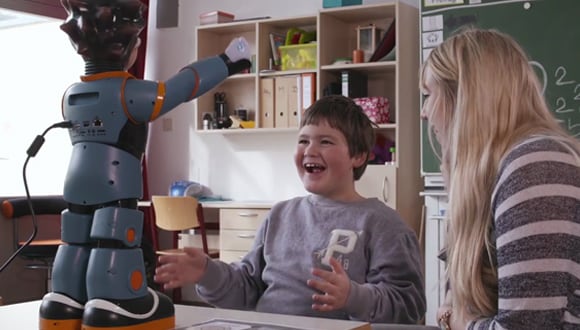Robots teaching social skills to children with autism
For children with autism, processing emotions and social cues can be a real challenge. Robot teachers may offer the right kind of support.
Health Agenda magazine
October 2018
For people with autism, a chat in a café can be a confusing and overwhelming experience. You might be distracted by conversations around you or the loud sounds of the coffee machine. Or you might not understand the non-verbal cues of the waitress or the expression on her face. You may have difficulty making yourself understood.
Although there are many different symptoms and varying levels of autism spectrum disorder (ASD), difficulty socially interacting is a common experience.
To engage children with autism and aid learning in social, communication and life skills, researchers are using human-like robots with simple facial expressions and non-threatening, predictable behaviour.

The robot-autism enigma
Several studies are underway to deliver the next generation of robot-enhanced therapy. Liz Pellicano, educational psychologist and professor at Macquarie University in Sydney, is involved in DE-ENIGMA, a large project running across 6 European countries. It focuses on creating a human-robot interaction that’ll enhance the social skills of children with ASD and help them better understand emotions and expressions.
The project’s star is Zeno, a small, endearing, boyish-looking robot with wide, dreamy-looking eyes. He was chosen because he can make facial expressions realistic enough but “when he makes his sad face, it’s exactly the same every time”, Pellicano explains. The consistency helps the children learn the expression and emotion.
DE-ENIGMA is currently working with 132 autistic children aged 5–12 who are mostly non-verbal. In the project’s next stage, researchers plan to use the collected data to make Zeno smarter. The goal is to develop an autonomous robot that will respond dynamically to an individual autistic child’s behaviour, rather than just act on pre-programmed responses. For instance, when a child feels overwhelmed by noises they may put their hands over their ears.
“Zeno might ‘think’ that the child is feeling something [negative], so might turn his volume down,” says Pellicano. “If we can pull that off, I think that will be an amazing feat.”
Dr Carolyn Garver, clinical director of the Autism Research Centre in Dallas, Texas, works with a robot named Milo, which is similar to Zeno. She remembers a 17-year-old patient who struggled with aggression, and his mother said he didn’t understand emotions at all.
One day, Dr Garver was working with the boy on understanding “sad”. She asked him, “Is Milo sad?” and he said, “Milo is sad.” Dr Garver looked at the boy and saw a huge tear running down his face. “I just lost it,” she says. “I was blown away that he actually expressed empathy. That was huge.”
Creating empathy and movement
Dr Christine Roberts-Yates, manager of Murray Bridge High School’s disability unit in South Australia, has also observed that robots “unwittingly create empathy”. She is researching Nao robots in collaboration with the CSIRO. Less human-like than Zeno and Milo, they look more like troopers from Star Wars, but with round eyes and a small mouth that gives them an innocent expression.
Dr Roberts-Yates says the children – with varying degrees of intellectual disability and autism – worry when the robots fall over. She recalls finding a boy with Down syndrome outside the classroom one day. When she asked him why he was there, he said, “The robot fell over and he’s hurt his leg.”
The children know the robots aren’t human beings, says Dr Roberts-Yates, but they’re very patient with them, and the robots have a calming influence. Her unit uses the robots as mentors to support the school curriculum, teaching skills that range from dance, spelling, maths, reading and chemistry experiments to holding a knife safely, shopping etiquette and manners. They even engage them in tai chi and yoga.
Robot opportunities
Dr Garver has observed that once children learn simple emotions from the robot, they’re better at identifying people’s emotions. Dr Roberts-Yates says that the families she works with report their children are “more confident, communicative, and more helpful at home”. But she highlights that robots are just computers and are only as good as the people working with them.
They’re a tool, and “we need as many tools as we can to work with these kids; we need to be innovative”, says Dr Garver.
Image credit: DE-ENIGMA Project
Related articles
WHEN GAMING TECH HELPS CANCER PATIENTS
A cutting edge virtual reality project is helping patients better understand cancer cells.
SERIOUS CONDITIONS THAT CAN BE MISSED
Many serious conditions have vague or hidden symptoms. Here’s how to identify and screen for them.
CAN TECHNOLOGY HELP OLDER PEOPLE STAY IN THEIR HOMES FOR LONGER?
Melbourne-based brothers are reimagining the way aged care is provided in Australia.